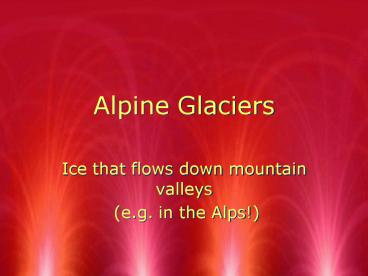Alpine Glaciers - PowerPoint PPT Presentation
1 / 17
Title:
Alpine Glaciers
Description:
(e.g. in the Alps!) Mont Blanc, near Chamonix, France - note the alpine glacier that flows to lower ... The Grand Teton (WY) is a classic horn - note several ... – PowerPoint PPT presentation
Number of Views:273
Avg rating:3.0/5.0
Title: Alpine Glaciers
1
Alpine Glaciers
- Ice that flows down mountain valleys
- (e.g. in the Alps!)
2
- Mont Blanc, near Chamonix, France - note the
alpine glacier that flows to lower elevations,
nearly reaching the main valley in which Chamonix
lies
3
Bergschrund at head of a glacier above Chamonix
4
Mer de Glace above Chamonix - note ogives
5
Rockfalls from the valley walls add debris to the
glaciers surface
6
Glaciers are capable of carrying debris of almost
any size - from the fine particles embedded in
the ice in the foreground, to the huge angular
boulder in the background
7
Landforms of Alpine Glaciation
- U-shaped valleys
- Cirques, Aretes, Horns
- Moraines
- Striations
8
Mer de Glace
- An alpine glacier, whose flow is confined to a
valley - Such glaciers are very efficient at eroding their
valleys, widening and deepening them into classic
U-shaped valleys
9
Fjord - a glacially eroded valley invaded by the
sea
10
Cirques are high basins where alpine glaciers
originate
Horn
Arete
Cirque
11
The Grand Teton (WY) is a classic horn - note
several small cirques that have eroded into the
mountain, leaving only a fairly narrow, jagged
peak.
12
Iceberg Lake (Glacier National Park, MT) occupies
a cirque The sheer rock face at the back of the
cirque is an arete - a narrow ridge between two
cirques that have eroded back into the mountain
from opposite sides
13
Portage Glacier (AK) - note lateral and medial
moraines
14
Medial moraines form where glacial tributaries
merge
15
End moraines form at the terminus of a glacier
16
Cirques with small residual glaciers in the Lyman
Valley, WA Note the end moraines, built of
debris deposited by the glaciers when they
extended a bit further downslope during the
Little Ice Age (1550-1850)
17
Glacial Abrasion
- Debris carried at the base of a glacier can
smooth and scratch the bedrock it flows over -
the scratches are called striations































